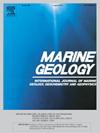通过识别沙质海啸沉积物以外的海啸痕迹对古海啸淹没区进行高精度估计:以公元869年日本东北部福岛佐干海啸为例
IF 2.6
3区 地球科学
Q2 GEOSCIENCES, MULTIDISCIPLINARY
引用次数: 0
摘要
以往的海啸沉积研究将可见砂质海啸沉积物的分布作为确定淹没区域和范围的工具,但由于海啸的实际淹没范围很少与可见砂质海啸沉积物的沉积范围一致,因此使用该区域进行海啸震级估计可能会导致其被低估。在本研究中,我们旨在通过沉积学和地球化学方法从海啸沉积物的沉积界限识别内陆海啸痕迹,以高精度重建869年发生在日本东北地区太平洋沿岸的Jogan海啸淹没区域。我们在福岛县南相马市收集了沉积物样本。根据放射性碳定年、砂粒粒度分析、海洋来源元素(如Ca和Sr)的增加以及特征生物标志物的存在,在距离现在海岸线2280米的地方发现了可见的约干海啸砂沉积痕迹。尽管在距离海岸线2790米的内陆地区没有观察到明显的沙质海啸沉积,但通过计算机断层扫描图像分析、沙子粒度分布、浮石的存在、角鲨烯的检测和其他异质生物标志物,可以推断出海水淹没的证据。对海啸痕迹的探测可以高度准确地估计海啸淹没地区,从而更准确地估计地震的震源和规模。本文章由计算机程序翻译,如有差异,请以英文原文为准。
High-precision estimation of a paleo-tsunami inundation area by identifying tsunami traces beyond sandy tsunami deposits: A case study of the 869 CE Jogan tsunami in Fukushima, northeastern Japan
Previous tsunami deposit studies have considered the distribution of visible sandy tsunami deposits as a tool to establish inundation areas and limits, but use of this area for tsunami magnitude estimation may cause it to be underestimated because the actual inundation limit of a tsunami rarely coincide with the depositional limit of visible sandy tsunami deposits. In this study, we aimed to reconstruct with high accuracy the inundation area of the Jogan tsunami, which occurred off the Pacific coast of the Tohoku region of Japan in 869 CE, by using sedimentological and geochemical methods to identify tsunami traces inland from the depositional limit of the tsunami deposits that are difficult to see by eye. We collected sediment samples at Minamisoma City, Fukushima Prefecture. Based on radiocarbon dating, grain-size analysis of sand, increased amounts of marine-derived elements such as Ca and Sr, and the presence of characteristic biomarkers, visible traces of sandy Jogan tsunami deposits were recognized up to 2280 m from the present coastline. Although no visible sandy tsunami deposits were observed farther inland, at 2790 m from the present coastline, evidence of seawater inundation was inferred from computed tomography image analysis, grain-size distribution of sand, presence of pumice, detection of squalene, and other allochthonous biomarkers. Detection of tsunami traces enables a highly accurate estimation of tsunami inundation areas, leading to a more accurate estimation of the source and scale of earthquakes.
求助全文
通过发布文献求助,成功后即可免费获取论文全文。
去求助
来源期刊

Marine Geology
地学-地球科学综合
CiteScore
6.10
自引率
6.90%
发文量
175
审稿时长
21.9 weeks
期刊介绍:
Marine Geology is the premier international journal on marine geological processes in the broadest sense. We seek papers that are comprehensive, interdisciplinary and synthetic that will be lasting contributions to the field. Although most papers are based on regional studies, they must demonstrate new findings of international significance. We accept papers on subjects as diverse as seafloor hydrothermal systems, beach dynamics, early diagenesis, microbiological studies in sediments, palaeoclimate studies and geophysical studies of the seabed. We encourage papers that address emerging new fields, for example the influence of anthropogenic processes on coastal/marine geology and coastal/marine geoarchaeology. We insist that the papers are concerned with the marine realm and that they deal with geology: with rocks, sediments, and physical and chemical processes affecting them. Papers should address scientific hypotheses: highly descriptive data compilations or papers that deal only with marine management and risk assessment should be submitted to other journals. Papers on laboratory or modelling studies must demonstrate direct relevance to marine processes or deposits. The primary criteria for acceptance of papers is that the science is of high quality, novel, significant, and of broad international interest.
 求助内容:
求助内容: 应助结果提醒方式:
应助结果提醒方式:


